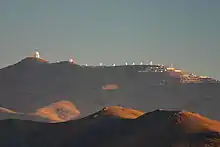Astronomy in Chile
Chile can be considered astronomy's world capital. In 2011,[2] Chile was home to 42% of the world's astronomical infrastructure consisting mostly of telescopes. In 2015 it expected to contain around 70% of the global infrastructure by 2020.[3] In the Atacama desert region of northern Chile, the skies are exceptionally clear and dry for more than 300 days a year. These conditions have attracted the world's scientific community to develop in the Atacama desert the most ambitious astronomical projects in the history of mankind.[4][5]

Chile's diverse and active astronomical community includes Chilean and international professionals and others, such as astronomers, engineers, students, teachers and amateurs.
The first documented testimony of an astronomical measurement done in Chile is the observation of a lunar eclipse by the soldier Pedro Cuadrado Chavino (June 1582).[6] He used a classic Greek method to obtain the latitude of the city of Valdivia based on the eclipse's measurements. In 1849, during the government of Manuel Bulnes, a scientific mission from the U.S. navy led by James Melville Gilliss arrived in Chile for observing Venus and Mars to calculate the Earth-Sun distance. The Gilliss mission established the first astronomical observatory in the Cerro Santa Lucia (Santiago). In 1852, the facilities were transferred to Chile and the National Astronomical Observatory was created.[7] During the second half of the 20th century, observatories from the U.S. and Europe were installed in different locations at the north of the country:[8] La Silla, Cerro Tololo, Las Campanas and later Cerro Paranal, Cerro Pachon and Chajnantor.
Chilean Astronomical Institutions
Professional astronomy
- Center for Excellence in Astrophysics and Associated Technologies, CATA - Spanish & English[9]
CATA is the largest Chilean project of R&D in astronomy's technologies. It is located in Calán Hill (Cerro Calán), in Santiago, Chile. This center has the largest number of astronomers in Chile from three universities: Universidad de Chile, Pontificia Universidad Católica de Chile and Universidad de Concepción. CATA develops nine different areas: six focused in scientific research, three focused on technology advances, and one on Education & Outreach (to students, teachers and general public).
- Millennium Center for Supernova Science - Spanish & English[10]
This Center is mainly dedicated to supernovae research, it gathers astronomers from: Universidad de Chile, Pontificia Universidad Católica de Chile and Universidad Andrés Bello.
Northern Chile
- Astronomy Center, University of Antofagasta[14]
- Astronomy Group, University of La Serena[15]
- Program in Physics mention in Astronomy, Catholic University of the North[16]
Central Chile
- Astronomy Department, Universidad de Chile (Spanish & English)
- Department of Astronomy and Astrophysics, Universidad Católica de Chile (English & Spanish)
- Department of Physics and Astronomy, University of Valparaíso
- Departamento de Astronomía Universidad Andrés Bello. (Spanish)
- Group of Earth and Space Science, University of Santiago. (in Spanish)
Southern Chile
- Astronomy Department, Universidad de Concepción. (Spanish and English)
Amateur astronomy
- Cerro Los Condores Observatory (Atacama Region)
- Cerro Mayu Observatory (Coquimbo Region)
- Cerro Mamalluca Observatory (Coquimbo Region)
- Cerro Collowara Observatory (Coquimbo Region)
- Astronomical Society of Valparaiso and Viña (SAVAL) (Valparaiso Region)
- Department of Astronomy (RASTRO), University of Concepcion (Bio-Bio Region)
- Chilean Association of Astronomy and Astronautics (ACHAYA) (Metropolitan Region)
- Metropolitan Amateur Astronomical Society (Metropolitan Region)
International astronomical institutions in Chile
- Carnegie Observatories
- European Southern Observatory (ESO)
- National Optical Astronomical Observatories [NOAO], USA)
- National Radioastronomical Observatories (NRAO, USA)
Observatories
Existing facilities

- National Astronomical Observatory (Chile)
- Cerro Tololo Inter-American Observatory: NOAO telescopes, SMART consortium, GONG, PROMPT, ALPACA.
- Cerro Pachon Observatory: Gemini Observatory, SOAR Telescope.
- Llano de Chajnantor Observatory: Cosmic Background Imager (CBI), Atacama Pathfinder Experiment (APEX), Q/U Imaging ExperimenT QUIET,
- Pampa La Bola and Purico Complex: Atacama Submillimeter Telescope Experiment (ASTE), NANTEN2 Observatory
- Paranal Observatory: Very Large Telescope (VLT), Visible & Infrared Survey Telescope for Astronomy (VISTA Telescope).
- Atacama Large Millimeter Array
- La Silla Observatory: ESO telescopes,
- Las Campanas Observatory: Carnegie telescopes, Magellan telescopes, Birmingham Solar Oscillations Network
- Cerro El Roble Observatory
- Manuel Foster Observatory
- TIGO (Transportable Integrated Geodetic Observatory)
Future facilities
- Giant Magellan Telescope (GMT) to be located at Las Campanas Observatory.
- European Extremely Large Telescope (ELT) to be located in Cerro Armazones.
- Vera C. Rubin Observatory to be located in Cerro Pachón Observatory (El Peñón).
- Overwhelmingly Large Telescope: not started. Potential sites in Chile were located in Antofagasta region.
Further information on Extremely large telescope.
Light pollution
Education
Undergraduate programs
- Astronomy Bachelor (Pontificia Universidad Católica de Chile)
- Astronomy Bachelor (Universidad de Chile)
- Astronomy Bachelor (Universidad de Concepcion)
- Bachelor in Physics, mention in Astronomy (Universidad de Valparaíso)
- Bachelor in Physics with mention in Astronomy (Universidad Andrés Bello)
- Bachelor in Physics, mention in Astronomy (Universidad de la Serena)
- Bachelor in Physics, mention in Astronomy (Universidad Católica del Norte)
Graduate programs
- Master in Astronomy (Universidad de Antofagasta)
- Master in Astronomy (Universidad de Chile)
- Ph.D. in Astronomy (Universidad de Chile)
- Master in Astronomy (Pontificia Universidad Católica de Chile)
- Ph.D in Astronomy (Pontificia Universidad Católica de Chile)
- Master in Astronomy (Universidad de La Serena)
- Master in Astronomy (Universidad de Concepción)
- Ph.D. in Astronomy (Universidad de Concepción)
School programs
- CADIAS
- Education and Outreach. Astronomy Department, University of Concepcion.
People
In Chile
In Chile there are more than 100 astronomers,[17] some are:
- Alejandro Clocchiatti (Pontificia Universidad Católica de Chile) Main Research Areas: Supernova and High-Performance Computing, member of the "High-Z Supernova Search Team". For this work the PI of the team, Brian P. Schmidt, was awarded the Physics Nobel Prize in 2011 for the discovery of the accelerated expansion of the Universe.
- Mario Hamuy (Universidad de Chile). Main Research Areas: Supernovae, Distance Scale, Observational Cosmology. Main Awards: Guggenheim Scholarship (2011) Hamuy is the second most cited scientist in Chile, and the most cited Chilean astronomer according to is SAO/NASA Astrophysics Data System. (Until June 2011)
- Dante Minniti (Pontificia Universidad Católica de Chile) Main Research Area: Birth & Evolution of Structures in the Universe
- José Maza (Universidad de Chile). Main Research Area: Supernovae. Main Award: National Prize for Exact Sciences (1999)
- Leopoldo Infante, (Pontificia Universidad Católica de Chile) Main Research Areas: Birth & Evolution of Structures in the Universe, Star Populations.
- María Teresa Ruiz (Universidad de Chile): Main Research Area: Brown Dwarfs. Main Award: National Prize for Exact Sciences (1997)
- Guido Garay (Universidad de Chile) Main Research Area: Star Formation
- Luis Barrera, (UMCE)
- Leonardo Bronfman, (Universidad de Chile) Main Research Areas: Molecular Clouds, Star Formation & Galactic and Structure, Astronomical Instrumentation
- Douglas Geisler (Universidad de Concepción)
- Wolfgang Gieren (Universidad de Concepción)
- Ronald Mennnickent (Universidad de Concepción)
- Marcelo Mora, (Pontificia Universidad Católica de Chile)
- Ramirez, Amelia (U. La Serena): dynamics and evolution of galaxies, galaxy groups and clusters.
- Munoz Ferrada, Carlos:[18] (former Director of the Astronomical Observatory of Panama) Main Research Area: Geodynamics
Engineers
- Seguel, Juan (CTIO): site testing of potentian astronomical places.
Amateur astronomers and teachers
- Gomez, Arturo: discoverer of the Gomez's Hamburger, a protoplanetary disk around a young low mass star.
- Jimenez, Carmen Gloria: teacher and psychologist working as Educational and Outreach Expert for the Astronomy Department of the Universidad de Concepcion. She is widely known for participating in the NASA's program "Teachers in Space" with chances to visit the International Space Station or participate as ground-based support for space missions of teachers.[19]
- Picetti, Battista: physics and astronomy teacher in the Seminario Conciliar de La Serena. He won the Michael Faraday Award for the Best Physics Teacher in 2007. Father Picetti is also the creator of El Tololito (La Serena) and Cerro Mayu Observatory[20]
Planetariums
- Planetarium of the Universidad de Santiago (Santiago)
- Gemini's Mobible Planetariums (La Serena)
- The Rapanui Planetarium located in Hanga Roa, Rapa Nui (a.k.a. Easter Island). The Planetarium has agreements with the Department of Astronomy of the University of Concepción as well as the University of Valparaíso. It offers free weekly activities for an average of 305 local schoolchildren from the following institutions: Liceo Lorenzo Baeza Vega, Hona'a o te Mana Aldea Educativa Rapa Nui, Colegio San Sebastián de Akivi, and Colegio Católico Hermano Eugenio Eyraud de Rapa Nui. This is a private venture founded by archaeoastronomers Edmundo Edwards and Barthelemy d'Ans to promote Rapanui and Polynesian ethnoastronomy in addition to traditional astronomy.
Publications and books
- Supernovas, José Maza, Mario Hamuy.
- Hijos de las estrellas, Maria Ruiz. ISBN 978-956-304-037-1
- Astronomía Contemporánea, José Maza
- Mundos lejanos, Dante Minniti.
- Con ojos de gigantes: la observación astronómica en el siglo XXI, L. Felipe Barrientos y Sebastian Lopez, Ediciones B. 2008
Astronomy in the media and news sites
- thisisChile.cl - Chile Official Website - Astronomy in Chile
- Chile_trip Yahoo! Group extensive collection of astronomy & travel resources in Chile
References
- "Incoming President of Chile Michelle Bachelet Meets Senior ESO Representatives". ESO Announcements. Retrieved 12 April 2014.
- "Why Chile is an astronomer's paradise", By Gideon Long BBC News
- "Chile to host 70 pct of global astronomical infrastructure by 2020". EFE. 15 April 2015. Retrieved 17 January 2017.
- "A panorama of the Chilean Astronomy", G. Garay, The ESO Messenger, March 2002, N. 107
- "Archived copy". Archived from the original on 2012-03-15. Retrieved 2012-01-27.CS1 maint: archived copy as title (link)"Chile has become a world-renowned hub in the field of astronomy". Interview to Mario Hamuy. Source: www.thisischile.cl
- "Historia General de Chile", Tomo 3, Diego Barros Arana (1884)
- "Cuatro siglos de Astronomia en Chile", H. Quintana, A. Salinas, (2004), Revista Universitaria, N. 83. Publicaciones P. Universidad Catolica de Chile
- ESO's early history, 1953-1975. VI - Further developments in Chile; 25 March 1969; The first phase dedicated; The introduction of national telescopes
- "Center for Excellence in Astrophysics and Associated Technologies Chile". www.cata.cl. Retrieved 29 January 2021.
- Millennium Center for Supernova Science https://web.archive.org/web/20120331104926/http://www.mcss.cl/nuevo/mcss2/?lang=en. Archived from the original on 31 March 2012. Missing or empty
|title=(help) - "Centra de Astrofisica". www.cenastro.cl. Archived from the original on 8 November 2006.
- "Investigación - Centro de Astrofísica de Valparaíso". Instituto de Física y Astronomía. p. 30 September 2015. Archived from the original on
|archive-url=requires|archive-date=(help). - "SOCHIAS – Sociedad Chilena de Astronomía". Retrieved 30 January 2021.
- "Centro de Astronomía de la Universidad de Antofagasta – Centro de Astronomía de la Universidad de Antofagasta" (in Spanish). Retrieved 30 January 2021.
- "Grupo de Astrofísica - ULS". www.dfuls.cl.
- "Facultad de Ciencias: Licenciatura en Física con Mención en Astronomía". Archived from the original on 31 August 2011.
- "Archived copy". Archived from the original on 2012-02-16. Retrieved 2012-01-27.CS1 maint: archived copy as title (link)
- "Nacionales de El Diario de Hoy:". archivo.elsalvador.com. Retrieved 2016-11-19.
- "Archived copy". Archived from the original on 2008-06-07. Retrieved 2008-07-12.CS1 maint: archived copy as title (link) "Maestra chilena es la primera latinoamericana que se prepara para ir al espacio", Icarito.
- Premios EduCiencias: Una vida dedicada a la ciencia y la educación Archived 2008-09-27 at the Wayback Machine, web site of Explora-CONYCIT.